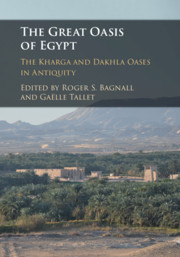Book contents
- The Great Oasis of Egypt
- The Great Oasis of Egypt
- Copyright page
- Contents
- Figures
- Tables
- Contributors
- Preface
- 1 Introduction
- Part I Living in the Oasis: Humans and the Environment
- 2 Water Resources and Irrigation in Two Oases of the Western Desert of Egypt: Kharga and Dakhla
- 3 The Ancient Population of the Kharga Oasis
- 4 Trimithis: A Case Study of Proto-Byzantine Urbanism
- Part II Managing the Oasis
- Part III Trade and Mobility in a Connected Environment
- Part IV An Oasis Culture?
- Bibliography
- Index of ancient people
- Index of places
- General index
4 - Trimithis: A Case Study of Proto-Byzantine Urbanism
from Part I - Living in the Oasis: Humans and the Environment
Published online by Cambridge University Press: 12 July 2019
- The Great Oasis of Egypt
- The Great Oasis of Egypt
- Copyright page
- Contents
- Figures
- Tables
- Contributors
- Preface
- 1 Introduction
- Part I Living in the Oasis: Humans and the Environment
- 2 Water Resources and Irrigation in Two Oases of the Western Desert of Egypt: Kharga and Dakhla
- 3 The Ancient Population of the Kharga Oasis
- 4 Trimithis: A Case Study of Proto-Byzantine Urbanism
- Part II Managing the Oasis
- Part III Trade and Mobility in a Connected Environment
- Part IV An Oasis Culture?
- Bibliography
- Index of ancient people
- Index of places
- General index
Summary
This chapter presents the landscape of ancient Trimithis, a polis in the fourth century AD, and a synthesis of its urban layout. The settlement extends over an irregular area in which moving sand dunes determined living spaces and the availability of water. Archaeological evidence attests the presence of a settlement at least from the Old Kingdom below the central hill on which the temple of Thoth stood from the New Kingdom to the Roman period. Our knowledge of the settlement life, history, and layout is still incomplete,but the fourth-century AD phase allows some comparisons with other cities of the Empire. The study of the buildings visible on the surface, of the excavated areas, and of the street layout suggests an imperial regular pattern of streets, with impressive public buildings like the thermae. The layout and architecture of Trimithis as they appear today resemble in several aspects the later Islamic medieval settlements of the oasis: vernacular architecture, compact organization of space, high density of buildings, labyrinthine layout, shaded or semi-shaded streets and alleys, sometimes closed with doors, and a certain disposition to close spaces to avoid exposure to sun and winds.
Keywords
- Type
- Chapter
- Information
- The Great Oasis of EgyptThe Kharga and Dakhla Oases in Antiquity, pp. 46 - 80Publisher: Cambridge University PressPrint publication year: 2019

